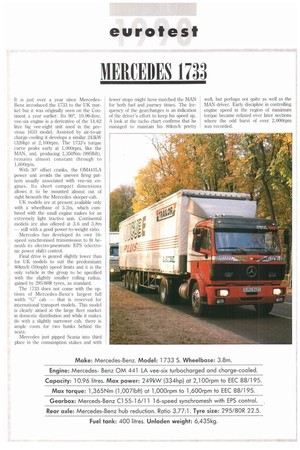MERCEDES 1733
Page 26

If you've noticed an error in this article please click here to report it so we can fix it.
It is just over a year since MercedesBenz introduced the 1733 to the UK market but it was originally seen on the Continent a year earlier. Its 90°, 10.96-litre, vee-six engine is a derivative of the 14.62 litre big vee-eight unit used in the previous 1633 model. Assisted by air-to-air charge-cooling it develops a similar 243kW (326hp) at 2,100rpm. The 1733's torque curve peaks early at 1,000rprn, like the MAN, and, producing 1,350Nm (9951bft), remains almost constant through to 1, 60Orpm.
With 30° offset cranks, the 0M4411,A power unit avoids the uneven firing pattern usually associated with vee-six engines. Its short compact dimensions allows it to be mounted almost out of sight beneath the Mercedes sleeper-cab.
UK models are at present available only with a wheelbase of 3.2m, which combined with the small engine makes for an extremely light tractive unit. Continental models are also offered at 3.6 and 3.8m — still with a good power-to-weight ratio.
Mercedes has developed its own 16speed synchronised transmission to fit beneath its electro-pneumatic EPS (electronic power shift) control.
Final drive is geared slightly lower than for UK models to suit the predominant 80km/h (50mph) speed limits and it is the only vehicle in the group to be specified with the slightly smaller rolling radius, gained by 295/80k tyres, as standard.
The 1733 does not come with the options of Mercedes-Benz's largest full width "G" cab — that is reserved for international transport models. This model is clearly aimed at the large fleet market in domestic distribution and while it makes do with a slightly narrower cab, there is ample room for two bunks behind the seats.
Mercedes just pipped Scania into third place in the consumption stakes and with fewer stops might have matched the MAN for both fuel and journey times. The frequency of the gearchanges is an indication of the driver's effort to keep his speed up. A look at the tacho chart confirms that he managed to maintain his 80knvh pretty well, but perhaps not quite as well as the MAN driver. Early discipline in controlling engine speed in the region of maximum torque became relaxed over later sections where the odd burst of over 2,000rprn was recorded.




















































